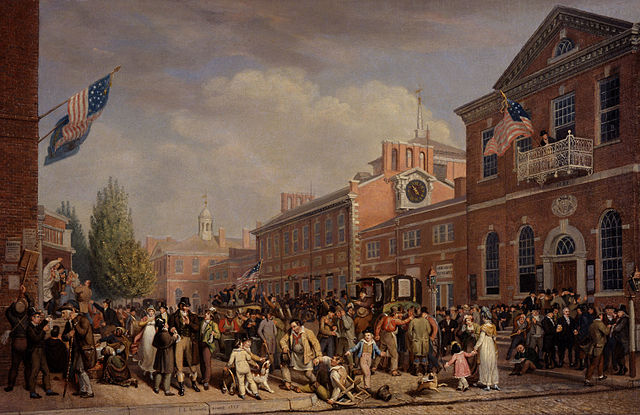History of American newspapers
The history of American newspapers begins in the early 18th century with the publication of the first colonial newspapers. American newspapers began as modest affairs—a sideline for printers. They became a political force in the campaign for American independence. Following independence the first amendment to U.S. Constitution guaranteed freedom of the press. The Postal Service Act of 1792 provided substantial subsidies: Newspapers were delivered up to 100 miles for a penny and beyond for 1.5 cents, when first class postage ranged from six cents to a quarter.

A selection of American newspapers from 1885, with portraits of their publishers. Top row: The Union and Advertiser (William Purcell) - The Omaha Daily Bee (Edward Rosewater) - The Boston Daily Globe (Charles H. Taylor) - Boston Morning Journal (William Warland Clapp) - The Kansas City Times (Morrison Mumford) - The Pittsburgh Dispatch (M. O'Neill). Middle row: Albany Evening Journal (John A. Sleicher) - The Milwaukee Sentinel (Horace Rublee) - The Philadelphia Record (William M. Singerly) -
The New England Courant, the 7 August 1721 front page
Fanciful drawing of a rural general store by Marguerite Martyn in the St. Louis Post-Dispatch of October 21, 1906. On the far left, a group of men share reading a newspaper.
Lincoln spins the news—a Copperhead cartoon from 1862 (note the horns)
The First Party System was the political party system in the United States between roughly 1792 and 1824. It featured two national parties competing for control of the presidency, Congress, and the states: the Federalist Party, created largely by Alexander Hamilton, and the rival Jeffersonian Democratic-Republican Party, formed by Thomas Jefferson and James Madison, usually called at the time the Republican Party.
Depiction of election-day activities in Philadelphia by John Lewis Krimmel, 1815





